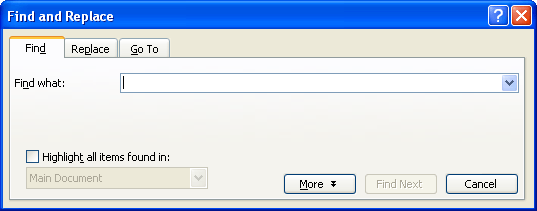Please Note: This article is written for users of the following Microsoft Word versions: 97, 2000, 2002, and 2003. If you are using a later version (Word 2007 or later), this tip may not work for you. For a version of this tip written specifically for later versions of Word, click here: Replacing an X with a Check Mark.
Cindi wants to use Find and Replace to replace a capital X with a check mark character. Specifically she wants to use the check mark character available in the Wingdings font. She's a bit unclear on how to do this type of replacing, however.
Actually, getting the results you want are relatively easy. There are several ways you can go about the task, but they all follow these general steps:

Figure 1. The Find tab of the Find and Replace dialog box.
This is fairly straightforward and should already be familiar to you. It is, after all, the basic method for doing most Find and Replace operations. The trick, however, is in how you do step 9. There are several ways you can specify the check mark character.
One way is to copy the check mark to the Clipboard before you start the steps. Just type the check mark into the document, as desired, and then use Ctrl+C to copy it to the Clipboard. Then, in step 9, you can either press Ctrl+V to paste it into the Replace With box or you can use the ^c characters to tell Word you want to use the contents of the Clipboard as your replacement.
Another way to specify your check mark is to remember that all characters have underlying character codes that are understood by Word. If you can find out the character code for the check mark (it is available in the Symbol dialog box if you use that method of creating the check mark), then you can use the code in the Find and Replace dialog box.
In this case, the character code for the check mark is 252, which must be entered using four characters and a carat mark. Thus, you would enter ^0252 in the Replace With box. When you do the replacement, you'll see the check mark (which corresponds to the character code) appear in your document.
WordTips is your source for cost-effective Microsoft Word training. (Microsoft Word is the most popular word processing software in the world.) This tip (7645) applies to Microsoft Word 97, 2000, 2002, and 2003. You can find a version of this tip for the ribbon interface of Word (Word 2007 and later) here: Replacing an X with a Check Mark.

Learning Made Easy! Quickly teach yourself how to format, publish, and share your content using Word 2021 or Microsoft 365. With Step by Step, you set the pace, building and practicing the skills you need, just when you need them! Check out Microsoft Word Step by Step today!
Need to search for information in a table? Word allows you to easily limit your search to an entire column or row, as ...
Discover MoreWhen you do a search and replace operation in Word, it is possible that you could inadvertently wipe out a bookmark or ...
Discover MoreNeed to find a character for which you only know the hex code? There are a few ways you can search for the information, ...
Discover MoreFREE SERVICE: Get tips like this every week in WordTips, a free productivity newsletter. Enter your address and click "Subscribe."
There are currently no comments for this tip. (Be the first to leave your comment—just use the simple form above!)
Got a version of Word that uses the menu interface (Word 97, Word 2000, Word 2002, or Word 2003)? This site is for you! If you use a later version of Word, visit our WordTips site focusing on the ribbon interface.
Visit the WordTips channel on YouTube
FREE SERVICE: Get tips like this every week in WordTips, a free productivity newsletter. Enter your address and click "Subscribe."
Copyright © 2026 Sharon Parq Associates, Inc.
Comments